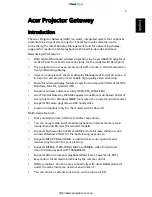
APPENDIX F - GLOSSARY
237
EATON
PXG600E User Manual • IM02603003E
Rev 5, 11-May-2012 • Firmware Version 5.03:3835
STP:
Shielded Twisted Pair (STP) is a type of copper telephone wiring in
which each of the two copper wires that are twisted together are coated with
an insulating coating that functions as a ground for the wires. The extra
covering in shielded twisted pair wiring protects the transmission line from
electromagnetic interference leaking into or out of the cable. STP cabling
often is used in Ethernet networks, especially fast data rate Ethernets
(Ethernet and Timing).
Subnet Mask:
A mask used to determine what subnet an IP address belongs
to. An IP address has two components, the network address and the host
address. For example, consider the IP address 150.215.017.009. Assuming
this is part of a Class B network, the first two numbers (150.215) represent
the Class B network address, and the second two numbers (017.009) identify
a particular host on this network.
TCP:
The Transmission Control Protocol (TCP) is one of the core protocols of
the Internet protocol suite, often simply referred to as TCP/IP. Using TCP,
applications on networked hosts can create connections to one another, over
which they can exchange streams of data using Stream Sockets. The
protocol guarantees reliable and in-order delivery of data from sender to
receiver. TCP also distinguishes data for multiple connections by concurrent
applications (e.g., Web server and e-mail server) running on the same host.
THD
: Total Harmonic Distortion (THD) is the effective value, or the value
associated with joule heating, of a periodic electromagnetic wave. The RMS
value is obtained by taking the square root of the mean of the squared value
of a function.
Timeout:
The amount of time allotted before a device stops processing a
command if the device is unable to complete the command.
USB:
The Universal Serial Bus (USB) is a serial bus standard to interface
devices. It was originally designed for personal computers, but it has
become commonplace on handheld devices such as portable memory
devices, video game consoles, PDAs and portable media players.
UTC:
UTC, also known as Coordinated Universal Time, is a high-precision
atomic time standard. UTC has uniform seconds defined by the International
Atomic Time (TAI), with leap seconds announced at irregular intervals to
compensate for the earth's slowing rotation and other discrepancies. Leap
seconds allow UTC to closely track Universal Time (UT), a time standard
based not on the uniform passage of seconds, but on Earth's angular
rotation. Time zones around the world are expressed as positive or negative
offsets from UTC. As the zero-point reference, UTC is also referred to as Zulu
time (Z). UTC is often referred to as Greenwich Mean Time when describing
time zones, although strictly speaking, it is only an approximation.
VAB, VBC, VCA:
Line-to-line voltage between phase a & b, phase b & c,
phase c & a, respectively
Waveform Data:
The numeric oscillographic values that may be captured. A
manifestation or representation or visualization of a wave, pulse or
transition (graph, plot, equation(s), table of coordinate or statistical data).
Web Browser:
A web browser is a software application that enables a user to
display and interact with text, images and other information typically located
on a web page which is part of a World Wide Web website or a local area
network.


































